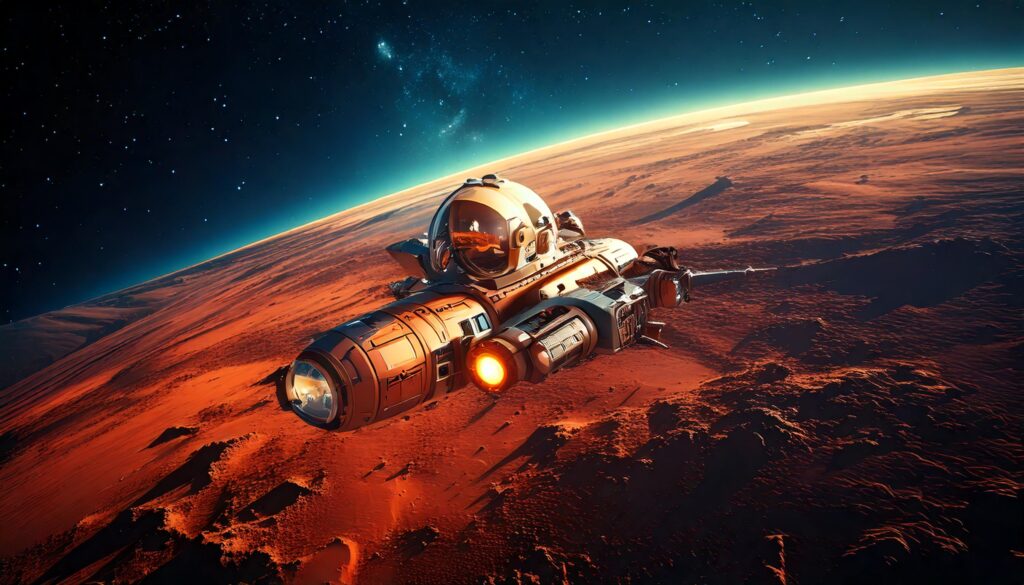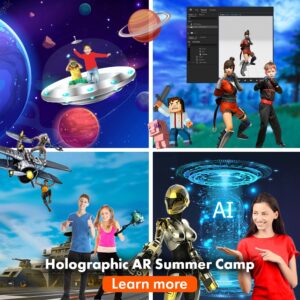
The “Mars Exploration with AR & AI” project brings students on a virtual mission to the Red Planet, offering an immersive way to explore Mars’ unique environment, surface features, and the role of rovers in space exploration. Using just a computer and a projector, TV, or smart board, teachers can introduce students to the wonders of Mars with interactive Augmented Reality (AR) and AI-guided conversations. This project allows students to experience simulated space travel, observe Mars’ rocky surface, and discuss the importance of resources like water—all designed to foster curiosity and deepen understanding.
Throughout the project, students will interact with Mars’ distinctive characteristics, such as its position in the solar system, its cold desert-like landscape, and the presence of ice near its poles. They will also learn about the role of rovers in collecting samples and studying Mars’ environment. Each stage is aligned with NGSS standards, creating a meaningful learning experience that emphasizes scientific inquiry and hands-on exploration. This guide offers step-by-step instructions, pre- and post-project activities, and discussion prompts to support teachers in creating an impactful Mars exploration experience. Download the project today to start this exciting journey with your students and spark their interest in planetary science.
Instruction Guide
Introduction to the Project:
- Stage 1: Launch and Space Travel – Introduce Mars as the fourth planet from the Sun and discuss its distance from Earth. Simulate the experience of traveling to Mars in a rocket, observing how the Sun appears smaller as we move farther from it.
- Stage 2: Explore – Land on Mars and observe its rocky, desert-like surface. Explain the temperature variations on Mars and how its thin atmosphere affects weather patterns, such as dust storms.
- Stage 3: Meet the Rover – Introduce the rover as a robotic partner exploring Mars. Explain the rover’s role in collecting samples and studying the planet’s surface, specifically why Mars is called the “Red Planet.”
- Stage 4: Discovering Water on Mars – Discuss the presence of ice and ice caps on Mars, especially near the poles, and explore why water is an important resource for life.
Each stage includes interactive AI-guided conversations to engage students with facts, questions, and visual demonstrations about Mars.
Learning Objectives and Outcomes
Learning Objectives with NGSS Standards Alignment:
- Understand Mars’ Position in the Solar System and Its Environmental Features
- Objective: Students will identify Mars as the fourth planet from the Sun and explore its distinctive environmental features, including its thin atmosphere and surface composition.
- NGSS Alignment: ESS1.B: Earth and the Solar System – Promotes understanding of planetary locations and their resulting environmental characteristics within the solar system.
- NGSS Code: 5-ESS1-2 – Represent data on planetary positions to reveal relationships, such as Mars’ position affecting its atmosphere and surface conditions.
- Explore the Concept of Distance in Space by Observing the Sun’s Appearance
- Objective: Students will explore how distance from the Sun affects its appearance and the amount of light and heat reaching Mars, compared to Earth.
- NGSS Alignment: ESS1.B: Earth and the Solar System – Introduces spatial relationships in the solar system, examining how distance impacts planetary light, temperature, and solar perception.
- NGSS Code: 5-ESS1-2 – Connects planetary distance from the Sun with observable patterns like temperature, light, and solar appearance.
- Discuss Mars’ Atmosphere, Surface Conditions, and Potential for Ice as a Resource
- Objective: Students will examine Mars’ thin atmosphere, surface conditions like dust storms, and the presence of ice, discussing these factors’ importance for exploration and potential resources.
- NGSS Alignment: ESS2.A: Earth Materials and Systems – Encourages exploration of atmospheric and surface properties on Mars, linking them to potential resources like ice.
- NGSS Code: 4-ESS2-2 – Analyze data on Mars’ surface and atmospheric conditions to describe patterns and discuss the significance of features like ice deposits for exploration.
- Understand the Role of Rovers in Planetary Exploration
- Objective: Students will learn about rovers’ role in collecting data on Mars, from analyzing surface samples to capturing images and studying environmental conditions.
- NGSS Alignment: ETS1.B: Developing Possible Solutions – Introduces the role of technology and engineering in exploration, with rovers as tools for gathering scientific data on other planets.
- NGSS Code: 3-5-ETS1-2 – Generate solutions and analyze the contributions of rovers in Mars exploration, fostering problem-solving and innovation in space science.
Learning Outcomes:
- Outcome 1: Students can summarize Mars’ key characteristics, such as its position, red surface color due to iron oxide, and its atmosphere’s impact on surface conditions.
- Outcome 2: Students engage in discussions about the importance of resources like water on Mars, the role of rovers in exploration, and the differences between Mars and Earth.
- Outcome 3: Students use scientific vocabulary aligned with NGSS and Common Core standards to describe Mars’ conditions, atmosphere, and exploration efforts.
Classroom Activity Design
Pre-AR Project Activities (Warm-Up & Background Building)
- Planetary Distances Visualization
- Objective: Introduce students to the concept of distance in the solar system.
- Activity: Use a scaled model (e.g., planets drawn on the playground) to show how far Mars is from the Sun compared to Earth. Discuss how distance affects travel time and appearance.
- Outcome: Provides a visual context for Mars’ distance from Earth and prepares students for the AR journey.
- Introduction to Mars Facts
- Objective: Prepare students with basic knowledge of Mars’ atmosphere, temperature, and surface.
- Activity: Create a “Mars Info Board” with facts about temperature, atmosphere, and the red surface. Allow students to add their guesses about why Mars is red and what they might find on its surface.
- Outcome: Engages curiosity and prepares students with basic information before they embark on the virtual Mars exploration.
Holographic AR Project: Mars Exploration with AR & AI
- Guided Experience: Students participate in the immersive AR journey, interacting with AI prompts that introduce them to Mars’ distance from Earth, surface conditions, temperature variations, and the presence of ice.
- AI Interaction: During the AR experience, students answer questions about what they observe, explore the role of a rover, and consider why Mars is called the “Red Planet.”
Post-AR Project Activities (Reinforcement & Hands-On Learning)
- Mars vs. Earth Discussion
- Objective: Reinforce key takeaways from the AR experience about the differences between Mars and Earth.
- Activity: In pairs or small groups, students discuss what they learned about Mars’ atmosphere, temperature, and surface features. Each student shares a “fun fact” and asks one question about Mars.
- Outcome: Encourages students to reflect on the experience, reinforcing comprehension through peer discussion.
- Design Your Mars Rover (Hands-On)
- Objective: Let students apply engineering principles to create their own model of a Mars rover.
- Activity: Using classroom materials (e.g., cardboard, straws, plastic lids), students design a small rover that could navigate Mars’ surface. They present their designs and explain how their rover would help explore Mars.
- Outcome: Encourages creativity and application of engineering concepts, linking directly to the role of rovers in the Mars AR experience.
- Water on Mars Inquiry
- Objective: Help students explore the significance of water on Mars.
- Activity: Students answer, “Why is finding water important on Mars?” and draw or write about how they think water might change Mars over time.
- Outcome: Deepens understanding of water’s importance to life and encourages students to think critically about planetary resources.
Classroom Management Tips
- Clear Viewing: Arrange seating to ensure all students have a clear view of the AR screen or TV. This helps maintain engagement and allows everyone to observe the AR interactions.
- Rotate Participation: Select different students to participate in each stage of the AR project. Use a turn-taking system to ensure all students have an opportunity to interact with the AI and feel included in the experience.
- Prepare Responses: Before the AR experience, help students prepare potential responses to AI prompts. This preparation encourages shy students to participate confidently and allows others to think through answers in advance.
- Inclusive Participation: Encourage shy or hesitant students by pairing them with peers or providing additional time to answer. Ensure that all students feel supported, particularly those who may need extra encouragement.
- Positive Reinforcement: Offer praise to each student who participates, reinforcing their effort and contributions to keep motivation high.
- Turn-Taking Reminders: Remind students that everyone will get a chance to interact with the AR project. This helps manage enthusiasm and ensures fair access for all.
Formative Assessments
Quick Check: After each stage, ask students to share one interesting fact they learned, such as how long it takes to travel to Mars or why Mars is red.
Reflection Journal: Students write a short entry summarizing one key aspect of Mars, such as its surface, atmosphere, or the role of the rover. Example prompts:
- “Describe what you learned about Mars’ surface.”
- “Why is Mars called the ‘Red Planet’?”
- “Why is finding water important for scientists studying Mars?”
Mars Fact Sheet: Provide a simple worksheet comparing Mars’ characteristics to Earth’s. Include questions like:
- “What is one way Mars’ atmosphere is different from Earth’s?”
- “How does Mars’ temperature compare to Earth’s?”
- “Why do scientists send rovers to Mars?”
Water Discovery Worksheet: After discussing water on Mars, students complete a worksheet with prompts such as:
- “Where is water found on Mars?”
- “Why do scientists think water on Mars is important?”
These formative assessments provide opportunities for students to summarize and reflect on what they learned, allowing teachers to gauge comprehension.
Cross-Subject Integration Suggestions
- Math: Calculate and visualize Mars’ distance from Earth (140 million miles) compared to other planets.
- Art: Create a visual model of Mars’ surface, including dust storms, ice caps, and rocks, inspired by the AR experience.
- Language Arts: Write a short story about traveling to Mars, describing what it would be like to live on Mars.
- History/Social Studies: Discuss the history of Mars exploration, including famous Mars rovers like Curiosity and Perseverance.




Recent Comments